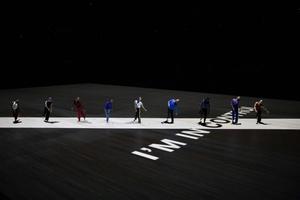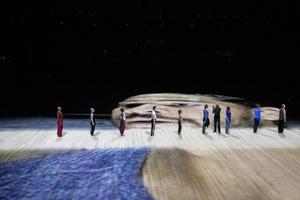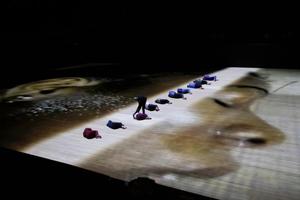DEEPBLUESEA
PARKAVENUEARMORY,NEWYORK,NEWYORK
The COVID-19 lockdown brought the production of Deep Blue Sea to an abrupt halt just weeks before its premiere at the Park Avenue Armory. When live performances resumed one and a half years later, the politically charged piece about race in America gained poignancy in the aftermath of George Floyd’s murder.
The work was inspired by a minor character in Herman Melville’s novel Moby Dick (1851). Embedded in the story of Captain Ahab’s obsession and revenge is a racial subplot involving the character Pip. While the crew is in pursuit of a whale, the young Black cabin boy falls overboard and is almost strangled in a harpoon rope. Facing the choice of either saving the boy and losing the whale or leaving the boy to drown, the second mate chooses to rescue Pip with the warning, “We can’t afford to lose whales by the likes of you; a whale would sell for thirty times what you would, Pip, in Alabama,” a reference to the boy’s price on the slave market. When Pip falls overboard a second time, he is left alone and adrift on the open sea.
This allusion to the disposability of a Black boy’s life speaks to an enduring racial injustice. Directed and performed by choreographer Bill T. Jones, the work is loosely autobiographical. As a gay Black choreographer in the predominantly white and straight downtown scene of the 1970s, Bill was always an outsider. Deep Blue Sea is an inflection point in Jones’s career: the struggle for racial justice takes center stage, and for him, Bill and Pip are intertwined.
The performance is structured in three sections that grow by multiples of ten. In section one, Bill is the lone performer onstage. In section two, he is joined by his company of ten dancers. In the last section, the dancers are again multiplied by a factor of ten: with local nonprofessional dancers joining Bill and his company, a community of one hundred people is formed.
The ethos of the performance is captured by several key scenes. After the house doors open and audience members file into the Drill Hall, they cross the stage and settle into their seats. Only then do they realize that Bill T. Jones has been among them all along, slowly tracing a figure eight across the floor. The performance had already begun before they entered. The house lights cross-fade slowly, almost imperceptibly, while a brightening spotlight tracks Bill’s movement around the stage and his natural voice is gradually amplified: Bill is becoming a theatrical body. As he delivers a string of seemingly incoherent yet familiar words, “Dream a Have I” (Martin Luther King Jr.’s famous speech in reverse), the spotlight fades to black, turning into a hole in the light on the stage, a “negative spotlight.” Bill is all but erased from view against the brightly lit floor as he intermittently recites passages from Moby Dick. On the giant stage, this lone performer is eclipsed at the same time that all attention is sharply focused on him. Dancers from Bill’s company then join him in pairs, and the group retraces the figure-eight path that Bill laid out. They link their bodies together in various configurations, becoming dependent on one another.
The climax is the desertion of Pip at sea and the profound loneliness he feels in the vast ocean before descending into the depths of madness and enlightenment. The Drill Hall is one of the largest performance spaces in New York, but even its immense scale is insufficient to capture Pip’s feeling of abandonment. The enormous hall had to be magnified: mirrors surrounding the stage are uncovered at key moments, infinitely extending the surface in all directions.
As the floor is cleared of performers, a video projection of the rolling sea fills the empty stage. A turbulent ocean soundscape of crashing waves is overlaid with haunting and melancholic vocals. The audience is left isolated and destabilized — stranded — for six uncomfortably long minutes. The stage is then pulled underwater as the camera sinks and all light is extinguished.
With the return of the company, Bill targets the sweat-covered face of each dancer with a handheld camera, asking, “What do you know?” posed in either a soft, inquisitive tone or a harsh, interrogatory one. The stage is then returned to its original state, and the full community of dancers appears. Several scenes later, the one hundred dancers lie on the floor, shoulder to shoulder, swaying back and forth as if in the tight quarters of a slave ship. Eventually, each dancer peels off to occupy a random position in a grid of spotlights. The dancers then take turns at an open mic, improvising a pithy personal statement each night. Afterward, Bill invites the audience to join him on stage, once again disappearing into the crowd as the spectators mix with the performers on the floor of the Drill Hall.
Deep Blue Sea was created in collaboration with choreographer Bill T. Jones, with music by Nick Hallett. The visual environment was a collaboration with projection designer Peter Nigrini.
| Location Park Avenue Armory, New York, United States |
| Team | Elizabeth Diller,Ricardo Scofidio,Matthew Johnson,Alex Knezo,Kumar Atre,and Andreas Kostopoulos |
| Bill T. Jones | Creator and Director |
| Bill T. Jones, Janet Wong, and the Bill T. Jones / Arnie Zane Company | Choreography |
| Elizabeth Diller, DS+R and Peter Nigrini | Visual Environment (Video Projection and Lighting Design) |
| Director Nick Hallett | Composer and Music |
| Hprizm aka High Priest, Rene Anakwe, and Holland Andrews | Electronic Score |
| Robert Wierzel | Lighting Design |
| Mark Grey | Sound Design |
| Liz Prince | Costume Design |
| Mark Hairston | Dramaturg |






